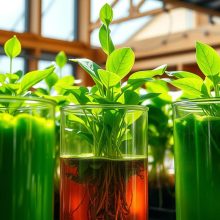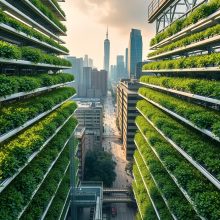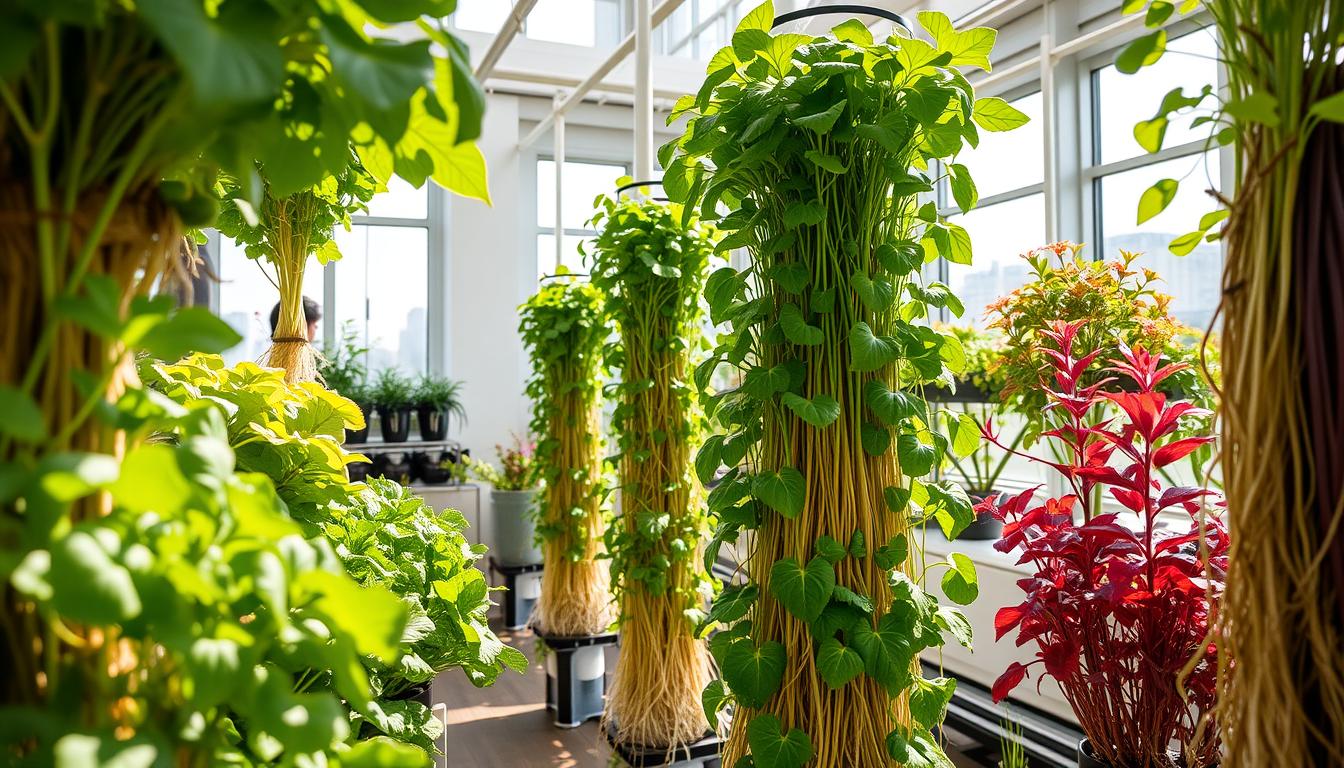Unlock the Power of Hydroponic Systems for Thriving Plants
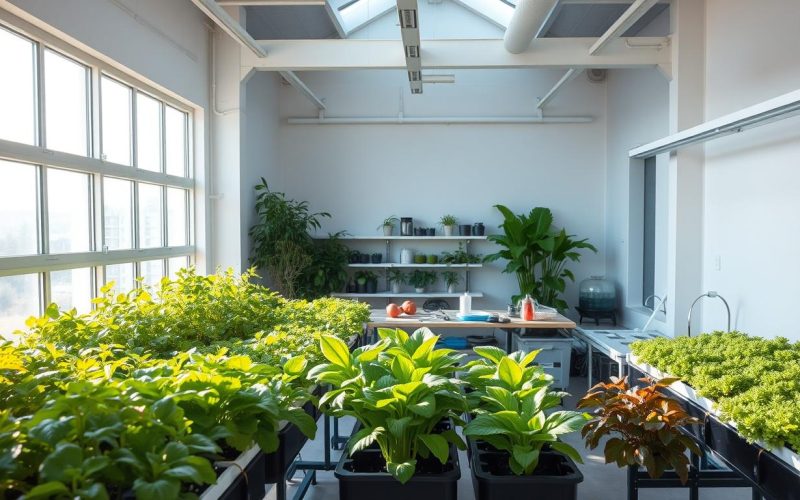
Gardening is changing with hydroponic systems. This new way of growing plants is different from old soil-based methods. It gives plants water full of nutrients right to their roots, helping them grow fast and strong.
Today’s farming needs better, smarter ways to grow plants. Hydroponic systems are a top choice for city farmers, home gardeners, and pros. They let people grow more plants in small spaces by controlling what plants eat and their environment.
Hydroponic systems skip the soil and focus on giving plants nutrients directly. This makes plants grow better and faster. Now, gardeners can grow fresh food all year, no matter the weather or where they are.
Key Takeaways
- Hydroponic systems eliminate traditional soil-based growing methods
- Direct nutrient delivery accelerates plant growth
- Suitable for urban and home gardening environments
- Enables year-round crop production
- Provides precise control over plant nutrition
Introduction to Hydroponic Systems
Hydroponic systems are a new way to grow plants, unlike traditional soil gardening. They use water rich in nutrients instead of soil. This method is exciting for farming and gardening at home.
Understanding Hydroponics
Hydroponics means plants get nutrients directly from water, not soil. This method has big benefits:
- Precise nutrient control
- Faster plant growth rates
- Reduced water consumption
- Ability to grow in limited spaces
Roots of Hydroponic Innovation
The idea of hydroponics isn’t new. Ancient people like the Babylonians used early versions of it. The Hanging Gardens of Babylon show how old hydroponics is.
In the 1930s, scientists started using water to grow plants. They found plants can get nutrients from water. This changed farming forever.
Today, hydroponics is used in labs, farms, and gardens. It’s great for cities, bad soil areas, and efficient farming.
Advantages of Hydroponic Systems
Hydroponic systems are changing the way we grow plants. They offer control over plant nutrition and the environment. This is a big step forward in agriculture.
Today, gardeners and farmers are seeing the benefits of hydroponics. These systems are changing the game for growing plants. They are great for both home and commercial use.
Faster Plant Growth
Hydroponics help plants grow faster. They get the nutrients they need right away. This means plants can grow 40-50% quicker than in soil.
What makes plants grow faster? It’s the direct access to nutrients and the perfect growing conditions. Plus, there are no limits from the soil.
- Direct root access to nutrients
- Controlled environmental parameters
- Elimination of soil-related growth restrictions
Space Efficiency
Hydroponics make the most of small spaces. They are perfect for growing in cities or small farms. You can grow up to 300% more than traditional farming.
Water Conservation
Hydroponics save a lot of water. They use 80-90% less water than regular farming. This makes them a green choice for farming today.
Types of Hydroponic Systems
Hydroponic systems let you grow plants without soil. Each design has its own benefits for healthy plants. Knowing the different types helps gardeners and farmers pick the best one for their needs.
Nutrient Film Technique (NFT)
The Nutrient Film Technique is a favorite among gardeners. It uses a thin stream of nutrient-rich water over plant roots. Plants sit in channels with roots in a shallow solution. It’s great for leafy greens and herbs.
Drip Systems
Drip systems send nutrients straight to plant roots through tubes and emitters. They’re efficient and work for many plants. You can control how much nutrient each plant gets, making them versatile.
Ebb and Flow Systems
- Periodically floods plant roots with nutrient solution
- Allows complete drainage between watering cycles
- Provides excellent oxygen exposure to root systems
Aeroponic and Deep Water Culture (DWC)
Deep Water Culture has roots in oxygenated, nutrient-rich water. Aeroponic systems mist roots with a fine spray. Both methods boost plant growth by improving nutrient and oxygen absorption.
Choosing the right hydroponic system depends on plant type, space, and growing goals. Each system has unique benefits for a thriving, sustainable garden.
Essential Components of Hydroponic Systems
Hydroponic systems need key parts to grow plants well. Knowing these parts is crucial for growing healthy crops.
Each system has special parts that help plants grow without soil. The right mix of these parts can change your gardening.
Growing Mediums
Growing mediums are vital for hydroponics. They support roots and help nutrients reach plants. Some good ones are:
- Rockwool: Keeps water well and supports roots
- Perlite: Light and helps with air
- Coconut coir: Good for the planet and holds moisture
- Clay pellets: Helps with drainage and air for roots
Nutrient Solutions
Nutrient solutions are key for hydroponics. They are special liquid fertilizers with all the nutrients plants need. Gardeners must keep these solutions balanced for plants to grow well.
Light Sources
Good lighting is important for hydroponics. You can use natural light or artificial lights like:
- LED grow lights: Save energy and last long
- Fluorescent lights: Good for small spaces
- High-intensity discharge (HID) lights: Best for big gardens
Choosing the right parts will help your hydroponic garden thrive. It will support strong plant growth.
Setting Up Your Hydroponic System
Creating a successful indoor hydroponic system needs careful planning and attention to detail. Whether you’re new or experienced, setting up your hydroponic setup is exciting and rewarding.
Before starting, choose the right location for your hydroponic system. The ideal spot should meet several key criteria:
- Consistent temperature between 65-75°F
- Access to electrical outlets
- Adequate natural or artificial light
- Protection from direct drafts
- Easy access for maintenance
Choosing Your System Components
When preparing your hydroponic setup, you’ll need essential components for healthy plant growth. Choose high-quality materials that can handle constant moisture and nutrient exposure.
- Choose a suitable growing container
- Select an appropriate growing medium
- Invest in a reliable water pump
- Purchase a complete nutrient solution
- Install proper lighting for indoor hydroponic systems
Step-by-Step Installation Guide
Start by assembling your hydroponic system carefully. Make sure all connections are secure and water-tight. Begin with a small setup to gain confidence and experience before expanding your indoor hydroponic systems.
Remember, patience and consistent monitoring are key to a thriving hydroponic garden. Each system is unique, so be prepared to make adjustments as you learn and grow.
Maintenance of Hydroponic Systems
Keeping your hydroponic systems in top shape needs your full attention and care. For plants to grow well, you must watch them closely and take care of them. This ensures they get the best conditions to thrive.
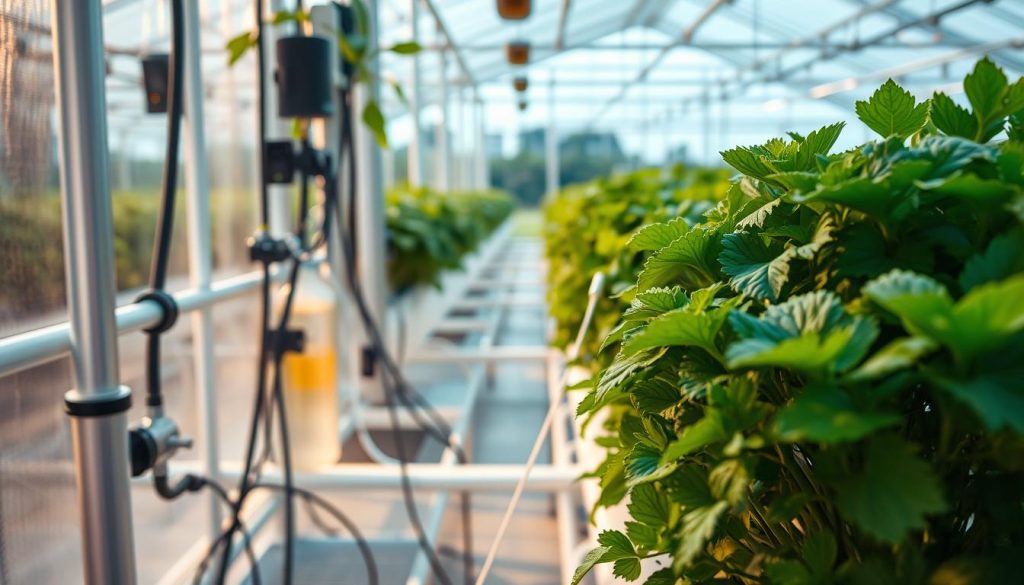
- Monitor water temperature consistently (65-75°F)
- Check nutrient solution quality weekly
- Inspect system components for potential issues
- Clean equipment using food-grade hydrogen peroxide
Regular Monitoring Needed
Hydroponic systems need constant watching. Set up a regular check schedule. This helps you keep an eye on water quality, plant health, and system performance. Tools like digital sensors can make this easier, giving you updates in real-time.
Prevention of Algae Growth
Algae can harm your hydroponic systems. To stop it, reduce light on nutrient solutions, keep reservoirs clean, and use dark containers. Regular cleaning and the right system design help control algae.
Adjustment of pH Levels
Keeping the right pH levels is key for nutrient uptake. Most plants do best in a pH of 5.5-6.5. Use accurate pH testing kits and solutions to keep your systems perfect for plant growth.
Common Mistakes in Hydroponics
Starting with hydroponic systems can be tough, even for experts. Many common mistakes can stop your plants from growing well. Knowing these mistakes helps you grow better plants.
Creating a successful hydroponic setup needs careful attention. Gardeners often face challenges that affect plant health and growth.
Overwatering and Nutrient Burn
- Watch for signs of root drowning in hydroponic systems
- Recognize excessive nutrient concentration symptoms
- Maintain proper nutrient solution balance
Overwatering is a big mistake in hydroponics. Plants need air as much as water. Too much water can cause root rot. Too much nutrient can also harm plants, causing leaves to turn color and possibly die.
Ignoring pH Levels
- Monitor pH levels regularly
- Maintain optimal pH range between 5.5-6.5
- Use digital pH meters for accurate measurements
pH levels are key for nutrient absorption in hydroponics. The wrong pH stops plants from getting the minerals they need. This can slow growth and harm plant health.
Inadequate Lighting
- Choose appropriate grow lights for specific plant needs
- Understand light spectrum requirements
- Provide consistent light cycles
Lighting is vital for hydroponic success. Not enough or the wrong light can lead to weak plants. This can also lower yields and plant health.
Hydroponics vs. Soil Gardening
Gardening fans are now looking into hydroponic systems as a new way to grow plants. These systems are different from growing in soil. They bring new benefits that soil gardening can’t match.
Today’s farming needs to be better and greener. Hydroponics offer a fresh way to grow plants. They solve many problems that soil gardening faces.
Nutritional Precision
- Hydroponic systems give nutrients straight to plant roots
- You can control exactly how much of each nutrient plants get
- No worries about soil not giving plants what they need
Environmental Impact
Hydroponics are good for the planet. They use up to 90% less water than growing in soil. This makes them a green way to farm.
- Less water used
- Needs less land
- No harmful runoff
- Smaller carbon footprint
Yield Differences
Studies show hydroponics can grow 20-25% more than soil gardening. This is because plants grow faster and more evenly. This leads to more crops all year round.
- Plants grow quicker
- Can grow plants all year
- More plants can grow together
- Fewer plants fail to grow
Even with all the benefits, hydroponics need money and know-how at first. Gardeners should think about what they need and have before switching.
Hydroponic Systems for Beginners
Starting with hydroponic systems can feel overwhelming at first. But, with the right steps, anyone can grow plants successfully. Beginner-friendly hydroponic systems make it easy to grow fresh produce at home.
New gardeners should look for simple setups that don’t need a lot of technical knowledge. The goal is to find a system that boosts confidence and shows quick results.
Easy-to-Manage Systems for New Growers
- Deep Water Culture (DWC) systems – perfect for beginners
- Wick hydroponic systems – low-maintenance and straightforward
- Small-scale indoor setups with basic nutrient delivery
Recommended Plants for Starter Hydroponic Gardens
Some plants do very well in hydroponic systems, making them great for beginners. When you buy hydroponic systems, consider these beginner-friendly options:
- Leafy greens like lettuce
- Herbs such as basil and mint
- Kale and other quick-growing brassicas
These plants grow fast and are easy on new hydroponic gardeners. They need less complex nutrient management and adjust well to controlled growing environments.
Beginners can find starter hydroponic systems at local gardening stores or online. Start small, learn the basics, and then grow your skills.
Innovations in Hydroponics
The world of hydroponics is changing fast, thanks to new technologies. Modern hydroponic systems now use advanced tech to change how we grow plants.
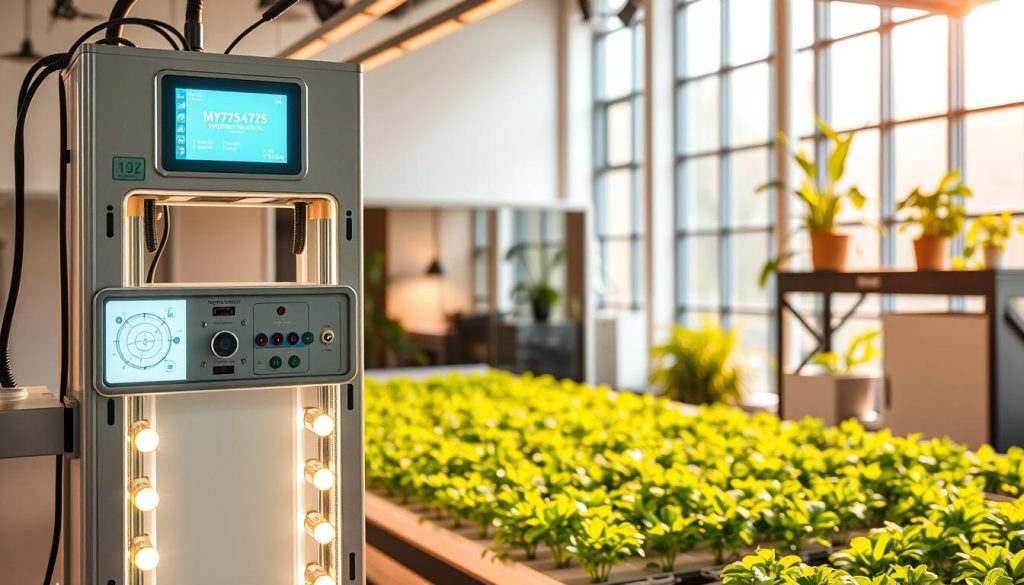
New ideas are changing indoor and commercial farming. Smart tech is making hydroponics easier, more efficient, and fun to use.
Automation in Hydroponic Systems
Now, automated hydroponic systems have cool features that make caring for plants easier:
- Self-regulating nutrient dosing
- Automated pH balancing
- Climate control systems
- Real-time plant health monitoring
Smart Technology Integration
Advanced hydroponic systems use the latest tech, like:
- Internet of Things (IoT) enabled monitoring platforms
- Smartphone-controlled environmental settings
- Artificial Intelligence-driven growth optimization
- Machine learning algorithms for predictive plant care
These new technologies are turning hydroponics into easy-to-use systems. Farmers and gardeners can now care for their plants with more precision and less effort.
The Future of Hydroponic Agriculture
Agriculture is changing fast, thanks to hydroponic systems. These systems are a new way to grow food, solving old farming problems. They make farming more sustainable and efficient.
Urban areas are seeing a big change in how food is grown. Hydroponics lets us grow food in places that were once not good for farming. Now, we see vertical gardens and rooftop farms in cities, making them productive.
Urban Farming Solutions
- Maximize limited urban spaces
- Reduce transportation costs for fresh produce
- Create local food production networks
- Minimize environmental impact
Hydroponics is very good for the planet. It uses a lot less water than old farming ways. Some systems use up to 90% less water and grow more food.
Sustainability and Hydroponics
- Water conservation
- Reduced carbon footprint
- Elimination of pesticide use
- Year-round crop production
New tech like aquaponics and vertical farming are taking hydroponics further. They mix fish farming with growing plants. This creates efficient systems that produce a lot of food.
Resources for Hydroponic Enthusiasts
Learning about hydroponic systems is a journey that never ends. It’s important to keep learning and connect with others who share your passion. Whether you’re just starting out or have been gardening for years, finding the right resources can make a big difference.
To grow your knowledge of hydroponic gardening, you need to explore different learning platforms. Here are some top resources to help you learn more:
Essential Learning Materials
- Recommended Books:
- Hydroponics for Beginners by Tyler Baras
- Advanced Hydroponic Systems by Dr. Howard Resh
- The Complete Hydroponics Handbook
Online Learning Platforms
- Udemy Hydroponic Courses
- Coursera Agricultural Technology Programs
- YouTube Educational Channels:
- Epic Gardening
- Khang Starr Hydroponics
Community Engagement Platforms
Connecting with other hydroponic fans can speed up your learning. It also gives you insights into various hydroponic systems. Key places to connect include:
- Reddit r/Hydroponics Forum
- Facebook Hydroponic Gardening Groups
- LinkedIn Professional Hydroponics Networks
Spending time on these resources will help you become a pro at hydroponic gardening. You’ll also stay up-to-date with the latest in sustainable farming.
Conclusion: Embrace Hydroponics for a Greener Future
Hydroponic systems are changing how we grow food. They give nutrients straight to plant roots, making farming more efficient and green. This method is great for growing food in cities, saving water, and getting more crops.
Everyone can help make farming better by trying hydroponics. Whether you garden at home or love farming, hydroponics help the planet. It’s getting easier to use in many places, helping us grow food in new ways.
As we face food shortages, hydroponics offer a solution. They help us grow food in a way that’s good for the planet. This means we can eat fresh, local food more often, saving money and the environment.
Our journey with hydroponics is just starting. With more research and tech, these systems will change how we farm. Exploring hydroponics is a step toward a greener future.
